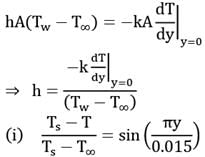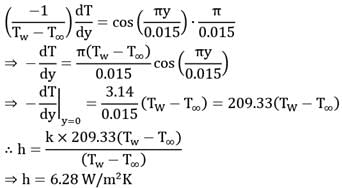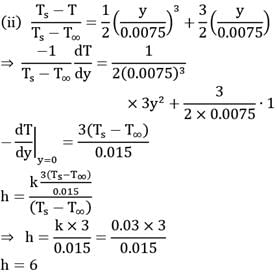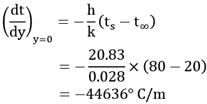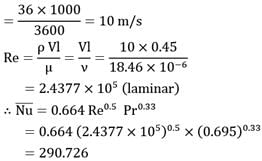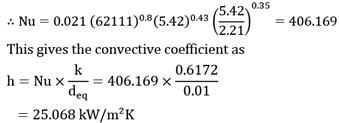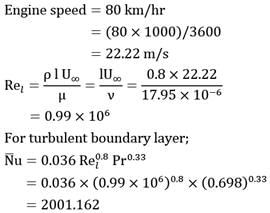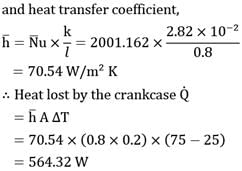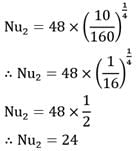Test: Convective Heat Transfer: One Dimensional Level - 2 - Mechanical Engineering MCQ
10 Questions MCQ Test - Test: Convective Heat Transfer: One Dimensional Level - 2
The temperature profile for a particular section for flow over a flat plate is prescribed by the identities

If thermal conductivity of air is stated to be 0.03W/m-oC , determine the value of convective heat transfer coefficient in each case in


If thermal conductivity of air is stated to be 0.03W/m-oC , determine the value of convective heat transfer coefficient in each case in

Air at 20°C flows over a flat surface maintained at 80°C. The value of heat transfer at a point was found to be 1250 W/m2. Proceed to calculate the temperature gradient (in °C/m) at the surface and the temperature (in °C) at a distance of 0.5 mm from the surface. Take thermal conductivity of air as 0.028 W/m-°C
| 1 Crore+ students have signed up on EduRev. Have you? Download the App |
Common Data for Question No. 3 & 4
Air at 25°C approaches a 0.9 m long by 0.6 m wide flat plate with an approach velocity 4.5 m/sec. The plate is heated to a surface temperature of 135°C.
It is given that at a temperature of 80°C, the thermo-physical properties of air are
v = 21.07 x 10-6m2/s
k = 0.0304 W/m-°C
Pr = 0.692
Make calculations for
The local heat transfer coefficient at a distance of 0.5 m from the leading edge is __________
Air at 25°C approaches a 0.9 m long by 0.6 m wide flat plate with an approach velocity 4.5 m/sec. The plate is heated to a surface temperature of 135°C.
It is given that at a temperature of 80°C, the thermo-physical properties of air are
v = 21.07 x 10-6m2/s
k = 0.0304 W/m-°C
Pr = 0.692
Make calculations for
Common Data for Question No. 3 & 4
Air at 25°C approaches a 0.9 m long by 0.6 m wide flat plate with an approach velocity 4.5 m/sec. The plate is heated to a surface temperature of 135°C.
It is given that at a temperature of 80°C, the thermo-physical properties of air are
v = 21.07 x 10-6m2/s
k = 0.0304 W/m-°C
Pr = 0.692
Make calculations for
The total rate of heat transfer from plate to the air is _________
Air moving at 0.3 m/s blows over the top of a chest-type freezer. The top of the freezer measures 0.9 m by 1.5 m and is poorly insulted so th a t th e su rface rem ains at 10 ° C . If the temperature of air is 30° C, make calculations for the maximum heat transfer rate by forced convection at the top of the freezer. At a temperature of 20°C, the thermophysical properties of air are
v = 15.06 x 10-6 m2/s
k = 0.0259 W/m-°C
Pr = 0.703
The oil pan of an IC engine approximates a flat plate 0.3 m wide by 0.45 m long and protrudes below the framework of the automobile. The engine oil is at 95°C and the ambient air
temperature is 35°C. If the automobile runs at 36 km/hr, make calculations for the rate of heat transfer (in W) from the oil-pan surface. Assume negligible resistance to conduction through the oil pan.
At the mean film temperature,

The thermo-physical properties of air are
v = 18.46 x 10-6m2/s
k = 0.0293 W/m-°C
Pr = 0.695
Predict your answer correct upto two decimal places.
Air flows through a 10 cm internal diameter tube at the rate of 75 kg/hr. Measurements indicate that at a particular section in the tube, the pressure and mixing cup temperature of air are 1.5 bar and 325 K respectively while the tube wall temperature is 375 K. The heat transfer rate (in W) for one meter length in the region is ________. The general nondimensional correlations for turbulent flow in the tube is
Nu = 0.023 Re0.8 Pr0.4
where the fluid properties are evaluated at the bulk temperature.
For air at tf = 325 K and p 1.5 bar, the thermo-physical properties of air are
μ = 1.967 x 10-5kg/ms
k = 0.02792 W/mK
and Pr = 0.713
A square channel with a side 10 mm and length 1.5 m carries water with a velocity of 5 m/s. measurements indicate that lengthwise mean temperature of water is 30°C whilst the inner surface of channel is at 80°C. Calculate the convective coefficient of heat transfer (in kW/m2- K) from th e channel wall to the water. Use the correlation

where the thermo-physical properties pertain to those at the mean bulk temperature of water. Prw corresponds to the value of Prandtl number at the channel surface temperature and equivalent diameter is the reference dimension.
The physical properties of water at 30°C are
p = 995.07 kg/m3
cP = 4174 J/kgK
k = 0.6172 W/mK
μ = 2.88 kg/m- hr
v = 0.805 x 10-6m2/s
Pr = 5.42
At wall:
Temperature tw = 80°C and Prw = 2.21
Predict your answer correct upto 2 decimal places.
For a particular car engine, the underside of the crankcase can be idealized as a flat plate measuring 80 cm x 20 cm. The car runs at 80 km/hr and the crankcase is cooled by the air flowing past it at the same speed. Make calcu lations for the loss of heat ( in W ) from the crank case surface (ts = 75°C) to the ambient air (t∞ = 25°C). Due to road induced vibrations, the boundary layer becomes turbulent from the leading edge itself.
At the mean film temperature of

the thermo-physical properties of air are
k = 2.824 x 10-2 W/mK
v = 17.95 x 10-6m2/s
and Pr = 0.698
Given; Nu = 0.036(ReL)0.8 x (Pr)0.33
The average Nusselt number in laminar natural convection from a vertical wall at 180°C with still air at 20°C is found to be 48. If the wall temperature becomes 30°C, all other parameter remaining same, the average Nusselt number will be


